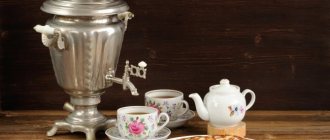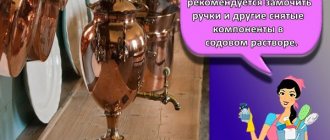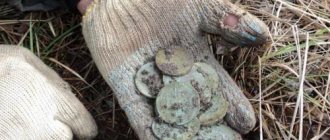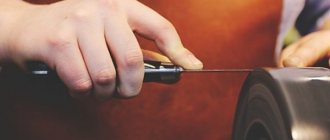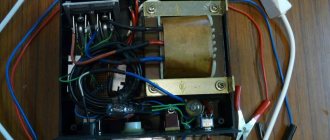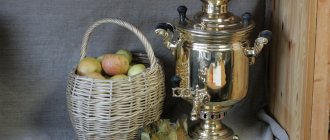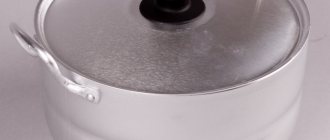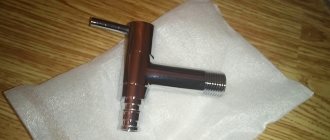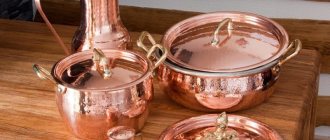A samovar is a water heater that belongs to ancient traditions that our ancestors maintained. It is also found in the homes of modern people. The advantage of the device is its ability to maintain water temperature for a long time, which is absent in other conventional kettles. Due to the widespread use, the question of how to clean a samovar is relevant for many people. It is relatively easy to clean it from plaque and other contaminants, and this can be done with improvised means.
Cleaning the brass surface
A brass samovar is cleaned with ammonia or oxalic acid.
Ammonia
Using ammonia for cleaning a regular and electric samovar:
- lightly moisten the cloth with ammonia;
- wipe the surface;
- rinse.
Oxalic acid
When working with oxalic acid, use gloves:
- stir oxalic acid in water according to the instructions (usually 100 g/3 l);
- moisten the surface of the device with liquid for 5 minutes;
- wash away;
- clean with soda;
- rinse;
- Rub the samovar until shiny with a soft cloth.
Cleaning small parts
Small parts of the samovar can be cleaned by boiling them for 30 minutes in a solution of water and soda ash (½ l:20 g).
Tips for use and care
- Draining the remaining cooled water after boiling will prevent scale formation.
- Brass samovars do not tolerate moisture. To preserve their appearance, they need to be stored in dry places.
- To prevent plaque from forming on the copper device, it is worth periodically wiping the surface with lemon and a soft brush.
- If possible, it is advisable to take the samovar to a professional polisher once every 5-15 years.
- Regularly wipe the product from dust. Sometimes take it apart and wash all parts.
- A hot appliance must not be left without water.
If you follow these simple rules, the samovar will delight you with delicious aromatic tea for decades.
Cleaning stainless steel surfaces
Stainless steel cookware loses its luster over time, becomes dull, and becomes stained. There are several options for cleaning a stainless steel samovar. The most commonly used are Goya paste and vinegar, available in every home.
Vinegar
Using vinegar is very simple:
- moisten a cotton pad or swab with 9% vinegar;
- wipe the surface.
Paste GOI
In addition to stainless steel, Goya paste can be used to clean copper samovars and brass products. It can not only clean, but also add shine:
- put a little paste on a soft cloth;
- clean the product;
- Remove residues with alcohol.
Important! Apply the paste gradually - after cleaning one area, apply it to another area.
How to polish a samovar
Harsh abrasives should not be used. They will leave noticeable scratches on a smooth metal surface.
To polish a samovar, use:
- GOI paste. This product is sold in hardware stores. Apply the paste to a soft cloth and gently rub the surface with gentle movements until it shines. Then rinse and wipe with a cloth.
- A mixture of tooth powder and 10% ammonia. Make a paste, apply a little to the surface and rub lightly with a cloth. To remove the composition, simply wipe the samovar with a damp cloth.
- Special products for polishing non-ferrous metals. They are sold in auto stores. Apply the product according to the instructions, wipe with a cloth - and the samovar will shine like new. But don't forget to wash the container thoroughly. Remember: these products are not intended for dishes, but for cars.
- Powdered chalk. The softest and most ineffective way. It is used for very sensitive but not contaminated surfaces.
Some dull areas can be polished with toothpaste. Choose not bleaching, but the most common toothpastes - they do not contain abrasives.
Internal cleaning
After cleaning the outer surface, you should remove the scale in the samovar, which can significantly distort the taste of the prepared drinks. You can clean the inside of the samovar using the following means.
Sweet sodas
The first option on how to clean the inside of a samovar is to use sweet sodas (for example, Sprite, Coca-Cola, etc.):
- pour soda into the samovar;
- leave overnight;
- pour out;
- clean off dirt with a brush;
- rinse.
Potato peelings
Using potato peelings is an old way to remove scale:
- rinse cleaning;
- pour them into the samovar;
- fill with water;
- boil for 30 minutes;
- leave to act for 2–3 hours;
- throw away the cleaning;
- rinse;
- Clean any remaining dirt with baking soda;
- rinse.
Cleaning the inside, done with scrubbing and baking soda, should be followed by boiling the water again to complete the process.
What not to clean
Stainless steel products cannot be cleaned with products containing various chlorine compounds. For all types of housings, the use of abrasives is highly discouraged, whether we are talking about products with abrasive particles or sandpaper.
If improperly maintained, the coating can be damaged.
Samovars with brass and copper bodies, as well as products with different decorative coatings, are especially sensitive to mechanical stress. For the same reason, you should avoid rough fabrics and hard brushes. Please note that brass does not tolerate acids, and it is not advisable to clean nickel with soda or powder.
It is very important to know what metal the samovar is made of and select a method based on this.
Folk remedies
In most situations, to restore the shine of brass products, it is enough to use traditional methods. The means at hand allow you to clean objects, regardless of their shape and size, without much expense.
Oxalic acid
A simple detergent, one of the ingredients of which is oxalic acid, is suitable for treating brass. The substance must be applied to a sponge, carefully treat the brass surface with it and wait for the reaction to appear. When exposed to acid, a small deposit will begin to form, which can be easily washed off under the pressure of water with a brush. After washing the product, you need to sprinkle soda on it, after 20-30 minutes, wash it again and rub it until shiny.
If it is necessary to perform deep cleaning, make a mixture of oxalic acid and warm water, observing the proportions of 200 g per 10 liters. An acid solution is prepared in a deep container, a contaminated object is placed inside, until it darkens and washed. This method is suitable for combating old stains caused by the oxidation process.
Acetone
Simple acetone can also restore the brass alloy to its original appearance. Acetone in its pure form or as part of a nail polish remover is suitable for cleaning. A cotton pad or soft sponge is generously moistened in the liquid and, applying force, wipe the stains on the product. You can use a similar method to clean copper objects.
Toothpaste
A common folk technique is the use of abrasive cleaning agents, including toothpaste. Squeeze a small amount of paste from the tube onto a toothbrush or rag and wipe the dull areas on the coating until the stains are completely removed. To achieve an effective result, you need to first wash the brass product in soapy water to remove stains that have arisen for other reasons (old grease, dirt, adhering dust).
Vinegar
Only recently appeared stains can be removed with undiluted vinegar. Heat the vinegar on the stove and wipe the brass with it. To clean a product with old stains, you need to dilute half a glass of vinegar and a tablespoon of salt in 2-3 liters of water. This mixture is heated to boiling point. When the solution boils, place an object inside and boil for 3-4 hours, periodically adding evaporating water. During a long boil, all stains will be washed away, and all that remains is to rub the surface to restore shine by polishing.
Lemon acid
Citric acid granules are sprinkled onto the brass coating and rubbed vigorously into the contaminated areas. You can also make a cleanser using half a lemon and a pinch of salt. The lemon is thoroughly coated in salt and the dark spots on the product are smeared. This method is suitable for removing both recent and old oxidation.
Emery
Sandpaper is used to clean large products with a large volume of oxides. For example, you can sand a brass basin or fireplace grate
It is important to consider that after rubbing with sandpaper, the product will lose its original shine, so you should resort to this method for items that do not require special handling. Brass jewelry, decorative items and rare items are cleaned using other means.
Soapy water
Newly appeared oxide stains can be removed with a soap solution. It is recommended to use laundry soap, which effectively cleans the brass surface. You can rub in soapy water using a soft cloth or sponge.
After soaking, the brass is rinsed with clean water, wiped and polished to restore its original shine.
Salt
You can clean brass with fine salt, which is mixed with low-fat cream. The mixture is applied to the oxidized areas and rubbed in. To treat old stains, it is recommended to pre-soak the mixture for an hour.
Vinegar dough
Using vinegar, a common method for processing sour dough is. It is suitable for application to products containing copper. The method is as follows:
- Mix 1 cup of flour and 0.5 cups of warm liquid and vinegar.
- The oxidized areas are covered with the resulting dough with a thick consistency and left to dry.
- After the dough has dried, it is carefully torn off the surface and the product is polished with a soft cloth.
As an additional measure, you can treat the product with a polishing agent. This will help restore the shine of the product.
General information
When was the samovar made?
The choice of cleaning agent depends on how long ago the samovar was manufactured. If the kitchen appliance was made a long time ago, it is recommended to remove the deposits that have formed from the inside, and the patina covering the outside of the samovar gives the product a special antique effect. Also, antique products will require more aggressive agents that can penetrate deep into the material.
Let's disassemble the device.
It is necessary to completely disassemble the samovar if there is a need to restore individual elements of the samovar. To remove contaminants, remove the cover so that the inner walls can be cleaned. Then remove the key, handles, crown and stand.
General recommendations
You can avoid the appearance of burning in rooms with a fireplace or stove, provided that you follow the rules for using heating facilities
It is important to clean chimneys on time. To do this, burn off the soot with aspen firewood, potato peelings or salt.
You can also purchase special products for cleaning pipes from soot.
Ammonia is used to remove soot from surfaces. It is added to water during wet cleaning. Ammonia, together with baking soda, added to water will help get rid of the acrid smell of smoke and burning. At the end of washing the apartment, you should use a sealant. It is applied to the walls, then primed. They do not forget that they begin freeing the house from soot and soot with dry cleaning, only then doing wet cleaning.
Share link:
